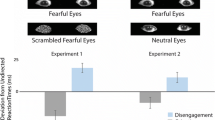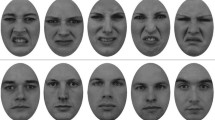Abstract
Fearful facial expressions are salient nonverbal social cues that signal the existence of potential threat within the environment. These threat signals capture spatial attention both when processed consciously (unmasked) and nonconsciously (masked). Studies using masked fearful faces have most reliably found speeded orienting towards their location, but delayed disengagement from this location has also been observed. Surprisingly however, the extent to which orienting and disengagement processes underlie modulations in spatial attention to conscious/unmasked fearful faces has yet to be explored. Here, participants performed an unmasked and masked fearful face dot-probe task, which included a baseline condition to assess attentional orienting and disengagement effects. We found that both unmasked and masked fearful faces capture spatial attention through facilitated orienting and delayed disengagement. These results provide new evidence that consciously and nonconsciously processed social expressions of fear facilitate attention through similar mechanisms.


Similar content being viewed by others
Notes
It should be noted that this effect is very likely driven by the order of the blocks. That is, overall reaction times decreased as participants became more familiar with the task.
We ran additional correlations to ensure that participants’ level of awareness did not influence orienting or disengagement scores, all p’s > .10 (Wiens, 2006).
References
Adolphs, R., Tranel, D., Hamann, S., Young, A. W., Calder, A. J., Phelps, E. A., et al. (1999). Recognition of facial emotion in nine individuals with bilateral amygdala damage. Neuropsychologia, 37(10), 1111–1117.
Arndt, J. E., & Fujiwara, E. (2012). Attentional bias towards angry faces in trait-reappraisal. Personality and Individual Differences, 52(1), 61–66. doi:10.1016/J.Paid.2011.08.030.
Carlson, J. M., Greenberg, T., & Mujica-Parodi, L. R. (2010). Blind rage? Heightened anger is associated with altered amygdala responses to masked and unmasked fearful faces. Psychiatry Research: Neuroimaging, 182, 281–283. doi:10.1016/j.pscychresns.2010.02.001.
Carlson, J. M., Mujica-Parodi, L. R., Harmon-Jones, E., & Hajcak, G. (2012). The orienting of spatial attention to backward masked fearful faces is associated with variation in the serotonin transporter gene. Emotion, 12(2), 203–207.
Carlson, J. M., & Reinke, K. S. (2008). Masked fearful faces modulate the orienting of covert spatial attention. Emotion, 8(4), 522–529. doi:10.1037/a0012653.
Carlson, J. M., & Reinke, K. S. (2010). Spatial attention-related modulation of the N170 by backward masked fearful faces. Brain and Cognition, 73(1), 20–27. doi:10.1016/j.bandc.2010.01.007.
Carlson, J. M., Reinke, K. S., & Habib, R. (2009). A left amygdala mediated network for rapid orienting to masked fearful faces. Neuropsychologia, 47(5), 1386–1389. doi:10.1016/j.neuropsychologia.2009.01.026.
Carlson, J. M., Reinke, K. S., LaMontagne, P. J., & Habib, R. (2011). Backward masked fearful faces enhance contralateral occipital cortical activity for visual targets within the spotlight of attention. Social Cognitive and Affective Neuroscience, 6(5), 639–645. doi:10.1093/Scan/Nsq076.
Cooper, R. M., & Langton, S. R. (2006). Attentional bias to angry faces using the dot-probe task? It depends when you look for it. Behavioral Research and Therapy, 44(9), 1321–1329.
Darwin, C. (1872). The expression of the emotions in man and animals. London: John Murray.
Etkin, A., Klemenhagen, K. C., Dudman, J. T., Rogan, M. T., Hen, R., Kandel, E. R., et al. (2004). Individual differences in trait anxiety predict the response of the basolateral amygdala to unconsciously processed fearful faces. Neuron, 44(6), 1043–1055. doi:10.1016/j.neuron.2004.12.006.
Feinstein, J. S., Adolphs, R., Damasio, A., & Tranell, D. (2011). The human amygdala and the induction and experience of fear. Current Biology, 21(1), 34–38. doi:10.1016/J.Cub.2010.11.042.
Fox, E. (2002). Processing emotional facial expressions: The role of anxiety and awareness. Cognitive Affective Behavioral Neuroscience, 2(1), 52–63.
Fox, E., Mathews, A., Calder, A. J., & Yiend, J. (2007). Anxiety and sensitivity to gaze direction in emotionally expressive faces. Emotion, 7(3), 478–486. doi:10.1037/1528-3542.7.3.478.
Fox, E., Russo, R., Bowles, R., & Dutton, K. (2001). Do threatening stimuli draw or hold visual attention in subclinical anxiety? Journal of Experimental Psychology: General, 130(4), 681–700.
Gur, R. C., Sara, R., Hagendoorn, M., Marom, O., Hughett, P., Macy, L., et al. (2002). A method for obtaining 3-dimensional facial expressions and its standardization for use in neurocognitive studies. Journal of Neuroscience Methods, 115(2), 137–143.
Koster, E. H., Crombez, G., Verschuere, B., & De Houwer, J. (2004). Selective attention to threat in the dot probe paradigm: Differentiating vigilance and difficulty to disengage. Behavioral Research and Therapy, 42(10), 1183–1192.
Koster, E. H., Crombez, G., Verschuere, B., Van Damme, S., & Wiersema, J. R. (2006). Components of attentional bias to threat in high trait anxiety: Facilitated engagement, impaired disengagement, and attentional avoidance. Behavioral Research and Therapy, 44(12), 1757–1771.
Liddell, B. J., Brown, K. J., Kemp, A. H., Barton, M. J., Das, P., Peduto, A., et al. (2005). A direct brainstem–amygdala–cortical ‘alarm’ system for subliminal signals of fear. Neuroimage, 24(1), 235–243.
MacLeod, C., & Mathews, A. (1988). Anxiety and the allocation of attention to threat. Quarterly Journal of Experimental Psychology A, 40(4), 653–670.
MacLeod, C., Mathews, A., & Tata, P. (1986). Attentional bias in emotional disorders. Journal of Abnormal Psychology, 95(1), 15–20.
Mathews, A., Fox, E., Yiend, J., & Calder, A. (2003). The face of fear: Effects of eye gaze and emotion on visual attention. Visual Cognition, 10(7), 823–835. doi:10.1080/13506280344000095.
Mogg, K., & Bradley, B. P. (1999). Some methodological issues in assessing attentional biases for threatening faces in anxiety: A replication study using a modified version of the probe detection task. Behavioral Research and Therapy, 37(6), 595–604.
Mogg, K., & Bradley, B. P. (2002). Selective orienting of attention to masked threat faces in social anxiety. Behavioral Research and Therapy, 40(12), 1403–1414.
Mogg, K., Bradley, B. P., de Bono, J., & Painter, M. (1997). Time course of attentional bias for threat information in non-clinical anxiety. Behavioral Research and Therapy, 35(4), 297–303.
Monk, C. S., Telzer, E. H., Mogg, K., Bradley, B. P., Mai, X., Louro, H. M., et al. (2008). Amygdala and ventrolateral prefrontal cortex activation to masked angry faces in children and adolescents with generalized anxiety disorder. Archives of General Psychiatry, 65(5), 568–576. doi:10.1001/archpsyc.65.5.568.
Morris, J. S., Frith, C. D., Perrett, D. I., Rowland, D., Young, A. W., Calder, A. J., et al. (1996). A differential neural response in the human amygdala to fearful and happy facial expressions. Nature, 383(6603), 812–815.
Posner, M. I. (1980). Orienting of attention. Quarterly Journal of Experimental Psychology, 32(1), 3–25.
Posner, M. I., Inhoff, A. W., Friedrich, F. J., & Cohen, A. (1987). Isolating attentional systems—A cognitive–anatomical analysis. Psychobiology, 15(2), 107–121.
Pourtois, G., Grandjean, D., Sander, D., & Vuilleumier, P. (2004). Electrophysiological correlates of rapid spatial orienting towards fearful faces. Cerebral Cortex, 14(6), 619–633.
Salemink, E., van den Hout, M. A., & Kindt, M. (2007). Selective attention and threat: Quick orienting versus slow disengagement and two versions of the dot probe task. Behavioral Research and Therapy, 45(3), 607–615.
Spielberger, C. D., Gorsuch, R. L., & Lushene, R. E. (1970). Manual for the State-Trait Anxiety Inventory (Self-Evaluation Questionnaire). Palo Alto, CA: Consulating Psychology Press.
Vuilleumier, P., Richardson, M. P., Armony, J. L., Driver, J., & Dolan, R. J. (2004). Distant influences of amygdala lesion on visual cortical activation during emotional face processing. Nature Neuroscience, 7(11), 1271–1278.
Whalen, P. J., Rauch, S. L., Etcoff, N. L., McInerney, S. C., Lee, M. B., & Jenike, M. A. (1998). Masked presentations of emotional facial expressions modulate amygdala activity without explicit knowledge. Journal of Neuroscience, 18(1), 411–418.
Wiens, S. (2006). Current concerns in visual masking. Emotion, 6(4), 675–680. doi:10.1037/1528-3542.6.4.675.
Yiend, J., & Mathews, A. (2001). Anxiety and attention to threatening pictures. Quarterly Journal of Experimental Psychology Section A-Human Experimental Psychology, 54(3), 665–681.
Acknowledgments
Research supported by Army Research Office Grant W911NF1110246 (LRMP & JMC).
Author information
Authors and Affiliations
Corresponding author
Rights and permissions
About this article
Cite this article
Carlson, J.M., Mujica-Parodi, L.R. Facilitated Attentional Orienting and Delayed Disengagement to Conscious and Nonconscious Fearful Faces. J Nonverbal Behav 39, 69–77 (2015). https://doi.org/10.1007/s10919-014-0185-1
Published:
Issue Date:
DOI: https://doi.org/10.1007/s10919-014-0185-1




